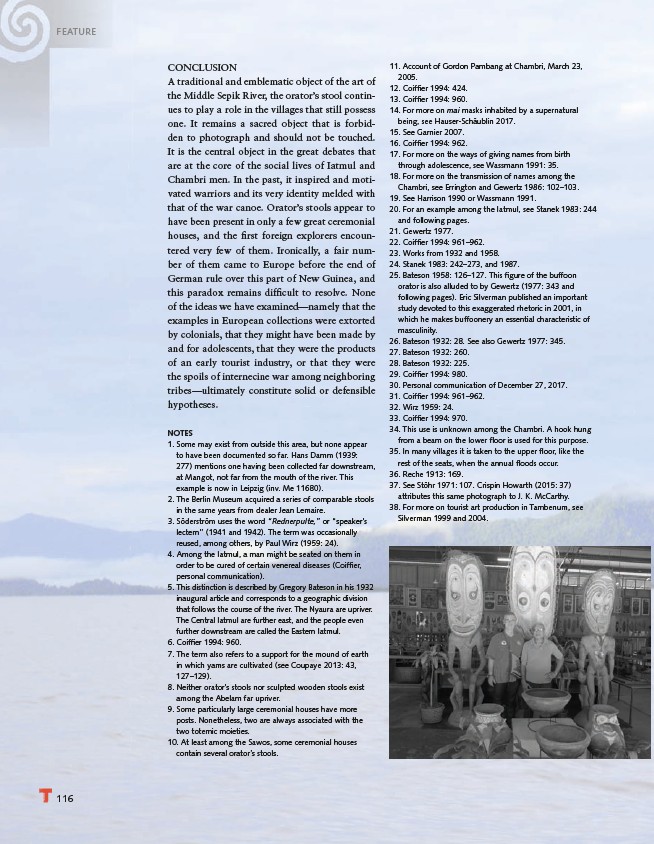
116
11. Account of Gordon Pambang at Chambri, March 23,
2005.
12. Coiffi er 1994: 424.
13. Coiffi er 1994: 960.
14. For more on mai masks inhabited by a supernatural
being, see Hauser-Schäublin 2017.
15. See Garnier 2007.
16. Coiffi er 1994: 962.
17. For more on the ways of giving names from birth
through adolescence, see Wassmann 1991: 35.
18. For more on the transmission of names among the
Chambri, see Errington and Gewertz 1986: 102–103.
19. See Harrison 1990 or Wassmann 1991.
20. For an example among the Iatmul, see Stanek 1983: 244
and following pages.
21. Gewertz 1977.
22. Coiffi er 1994: 961–962.
23. Works from 1932 and 1958.
24. Stanek 1983: 242–273, and 1987.
25. Bateson 1958: 126–127. This fi gure of the buffoon
orator is also alluded to by Gewertz (1977: 343 and
following pages). Eric Silverman published an important
study devoted to this exaggerated rhetoric in 2001, in
which he makes buffoonery an essential characteristic of
masculinity.
26. Bateson 1932: 28. See also Gewertz 1977: 345.
27. Bateson 1932: 260.
28. Bateson 1932: 225.
29. Coiffi er 1994: 980.
30. Personal communication of December 27, 2017.
31. Coiffi er 1994: 961–962.
32. Wirz 1959: 24.
33. Coiffi er 1994: 970.
34. This use is unknown among the Chambri. A hook hung
from a beam on the lower fl oor is used for this purpose.
35. In many villages it is taken to the upper fl oor, like the
rest of the seats, when the annual fl oods occur.
36. Reche 1913: 169.
37. See Stöhr 1971: 107. Crispin Howarth (2015: 37)
attributes this same photograph to J. K. McCarthy.
38. For more on tourist art production in Tambenum, see
Silverman 1999 and 2004.
FEATURE
CONCLUSION
A traditional and emblematic object of the art of
the Middle Sepik River, the orator’s stool continues
to play a role in the villages that still possess
one. It remains a sacred object that is forbidden
to photograph and should not be touched.
It is the central object in the great debates that
are at the core of the social lives of Iatmul and
Chambri men. In the past, it inspired and motivated
warriors and its very identity melded with
that of the war canoe. Orator’s stools appear to
have been present in only a few great ceremonial
houses, and the fi rst foreign explorers encountered
very few of them. Ironically, a fair number
of them came to Europe before the end of
German rule over this part of New Guinea, and
this paradox remains diffi cult to resolve. None
of the ideas we have examined—namely that the
examples in European collections were extorted
by colonials, that they might have been made by
and for adolescents, that they were the products
of an early tourist industry, or that they were
the spoils of internecine war among neighboring
tribes—ultimately constitute solid or defensible
hypotheses.
NOTES
1. Some may exist from outside this area, but none appear
to have been documented so far. Hans Damm (1939:
277) mentions one having been collected far downstream,
at Mangot, not far from the mouth of the river. This
example is now in Leipzig (inv. Me 11680).
2. The Berlin Museum acquired a series of comparable stools
in the same years from dealer Jean Lemaire.
3. Söderström uses the word “Rednerpulte,” or “speaker’s
lectern” (1941 and 1942). The term was occasionally
reused, among others, by Paul Wirz (1959: 24).
4. Among the Iatmul, a man might be seated on them in
order to be cured of certain venereal diseases (Coiffi er,
personal communication).
5. This distinction is described by Gregory Bateson in his 1932
inaugural article and corresponds to a geographic division
that follows the course of the river. The Nyaura are upriver.
The Central Iatmul are further east, and the people even
further downstream are called the Eastern Iatmul.
6. Coiffi er 1994: 960.
7. The term also refers to a support for the mound of earth
in which yams are cultivated (see Coupaye 2013: 43,
127–129).
8. Neither orator’s stools nor sculpted wooden stools exist
among the Abelam far upriver.
9. Some particularly large ceremonial houses have more
posts. Nonetheless, two are always associated with the
two totemic moieties.
10. At least among the Sawos, some ceremonial houses
contain several orator’s stools.